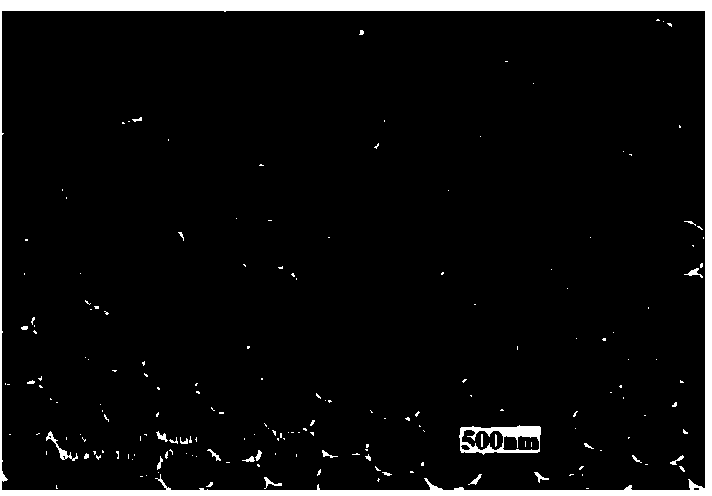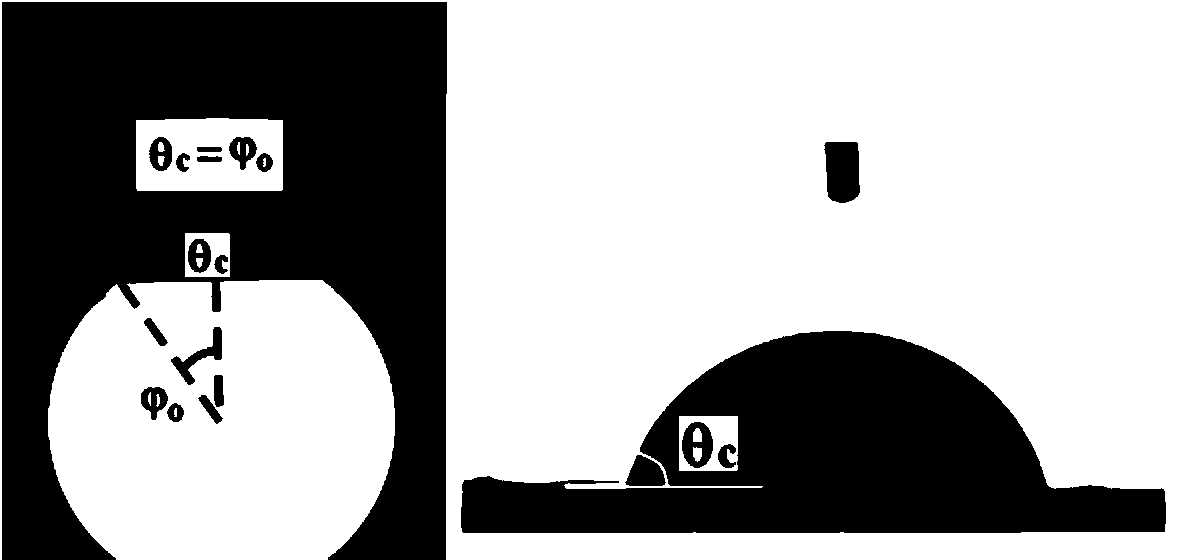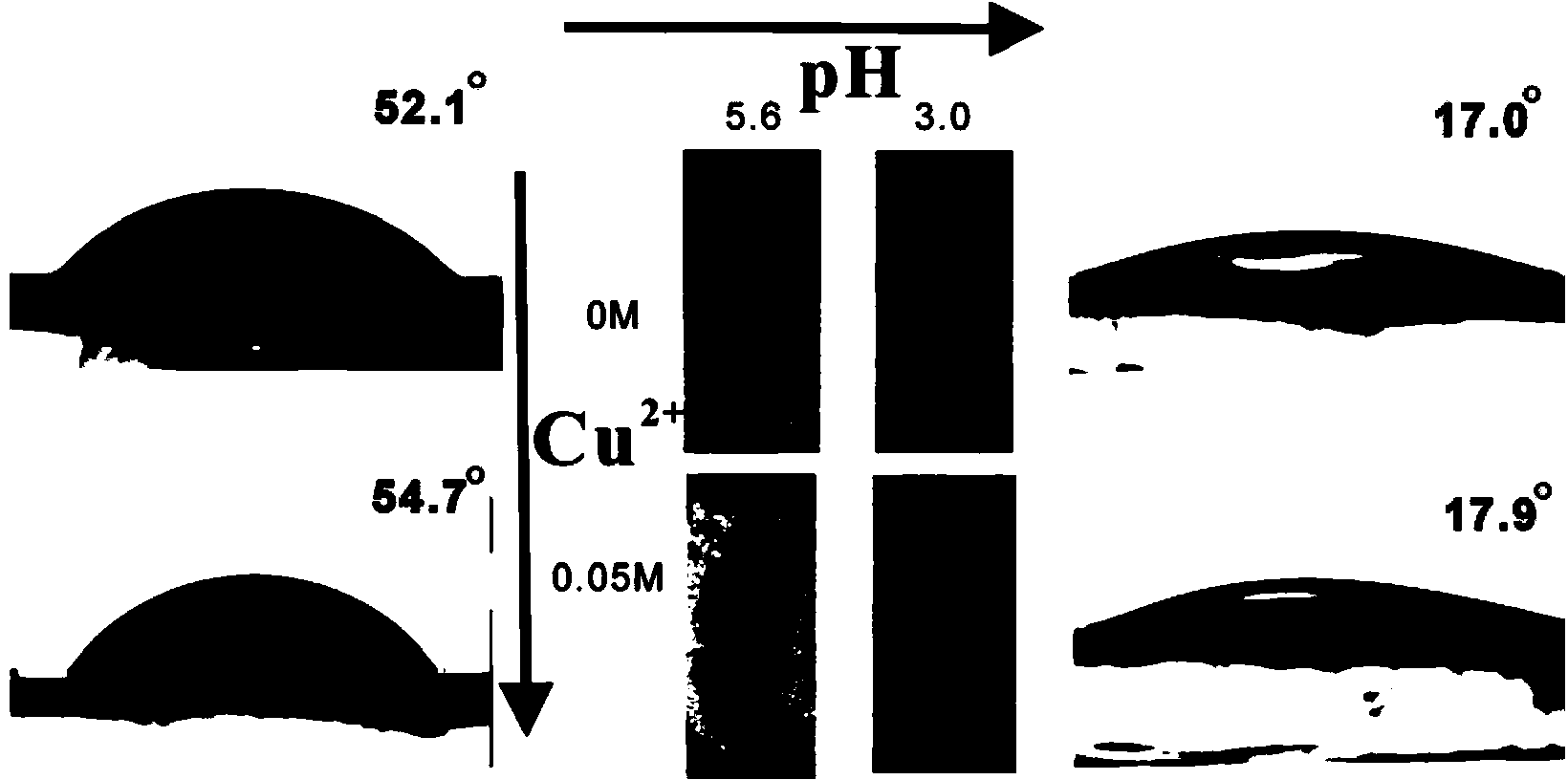Method for measuring pH by using photonic crystal wettability
A photonic crystal and wettability technology, applied in the field of pH measurement, can solve the problems of low measurement accuracy and poor stability, and achieve the effects of stable measurement value, simple equipment and accurate pH measurement value
- Summary
- Abstract
- Description
- Claims
- Application Information
AI Technical Summary
Problems solved by technology
Method used
Image
Examples
Embodiment 1
[0030] A method for measuring pH utilizing wettability of photonic crystals, adopting the following steps:
[0031] 1) Synthesis of monodisperse silica microspheres by sol-gel method: take 36mL of absolute ethanol, keep the temperature at 25°C, add 1.7g of tetraethyl orthosilicate, 1.7g of water, and 1.7g of ammonia in sequence, stir well, and React at 25°C for more than 10 hours to obtain an ethanol dispersion of microspheres;
[0032] 2) Dilute the emulsion prepared in step 1) into a 0.7% ethanol emulsion by centrifugation-ultrasonic purification, and deposit silica microspheres in a thermostat at a temperature of 25°C by self-assembly method A silica opal photonic crystal film is formed on a glass substrate, using the film as a template:
[0033] 3) Take 14 templates obtained in step 2), drop them into the polymer precursor solution (mass fraction) of the following formula, and polymerize under normal temperature by ultraviolet light:
[0034]
[0035]
[0036] 4) U...
Embodiment 2
[0040] A method for measuring pH utilizing wettability of photonic crystals, adopting the following steps:
[0041] 1) Synthesis of monodisperse silica microspheres by sol-gel method: take 50mL of absolute ethanol, keep the temperature at 22°C, add 1.7g of tetraethyl orthosilicate, 2g of water, and 1.5g of ammonia in sequence, stir well, and Reaction at ℃ for more than 10 hours to obtain ethanol dispersion of microspheres;
[0042] 2) Dilute the emulsion prepared in step 1) into an ethanol emulsion with a mass fraction of 0.8% after centrifugal-ultrasonic purification, and deposit silica microspheres in an incubator at a temperature of 28°C by self-assembly method A silica opal photonic crystal film is formed on a glass substrate, using the film as a template:
[0043] 3) Take 10 templates obtained in step 2), drop them into the polymer precursor solution (mass fraction) of the following formula, and polymerize under normal temperature by ultraviolet light:
[0044] ...
Embodiment 3
[0049]A method for measuring pH utilizing wettability of photonic crystals, adopting the following steps:
[0050] 1) Synthesis of monodisperse silica microspheres by persol-gel method: take 40mL of absolute ethanol, keep the temperature at 26°C, add 1.5g of tetraethyl orthosilicate, 2.2g of water, and 1.6g of ammonia water in sequence, stir evenly, and React at 26°C for more than 10 hours to obtain an ethanol dispersion of microspheres;
[0051] 2) Dilute the emulsion prepared in step 1) into a 1% ethanol emulsion by centrifugation-ultrasonic purification, and deposit silica microspheres in a thermostat at a temperature of 30°C by self-assembly method A silica opal photonic crystal film is formed on a glass substrate, using the film as a template:
[0052] 3) Take 20 templates obtained in step 2), and drop them into the polymer precursor solution (mass
[0053] Quantity fraction), polymerized at normal temperature by ultraviolet light:
[0054]
[0055] 4) Using 1.8...
PUM
 Login to View More
Login to View More Abstract
Description
Claims
Application Information
 Login to View More
Login to View More - R&D Engineer
- R&D Manager
- IP Professional
- Industry Leading Data Capabilities
- Powerful AI technology
- Patent DNA Extraction
Browse by: Latest US Patents, China's latest patents, Technical Efficacy Thesaurus, Application Domain, Technology Topic, Popular Technical Reports.
© 2024 PatSnap. All rights reserved.Legal|Privacy policy|Modern Slavery Act Transparency Statement|Sitemap|About US| Contact US: help@patsnap.com










